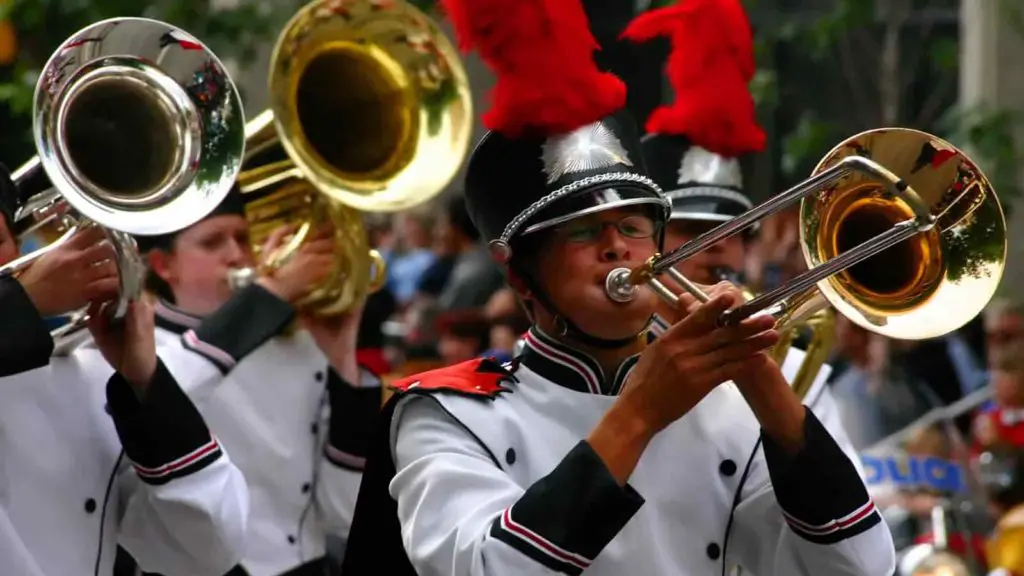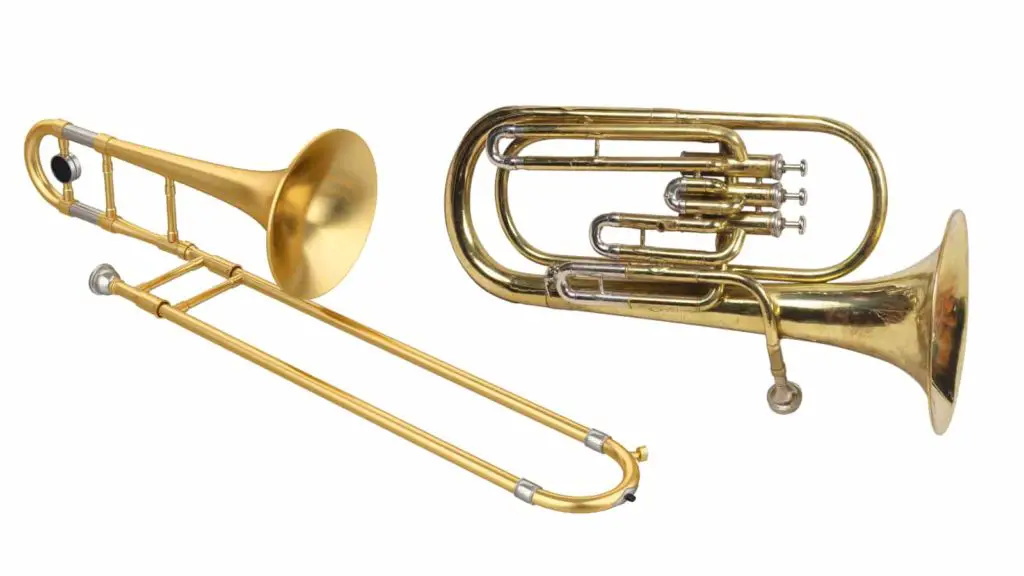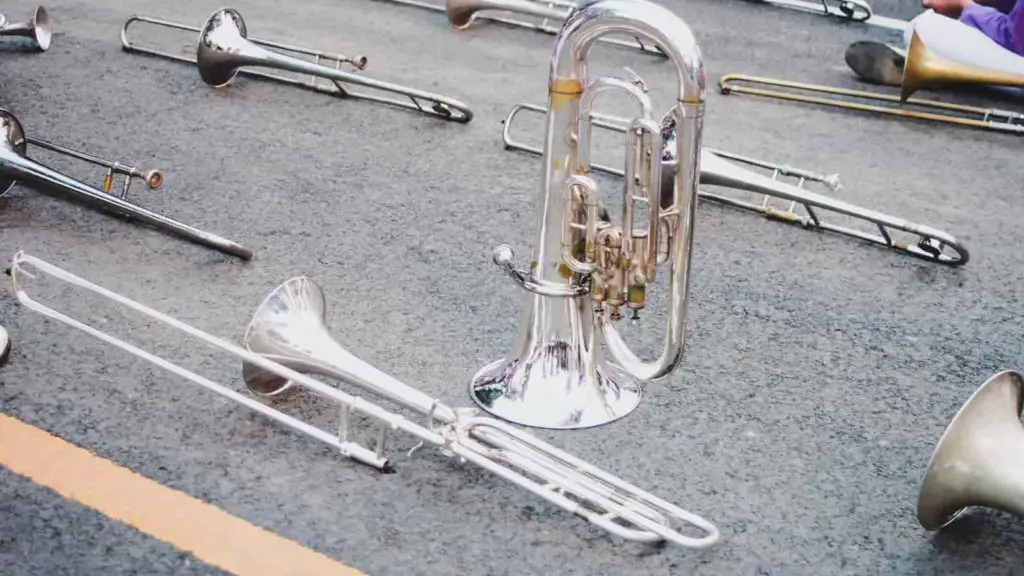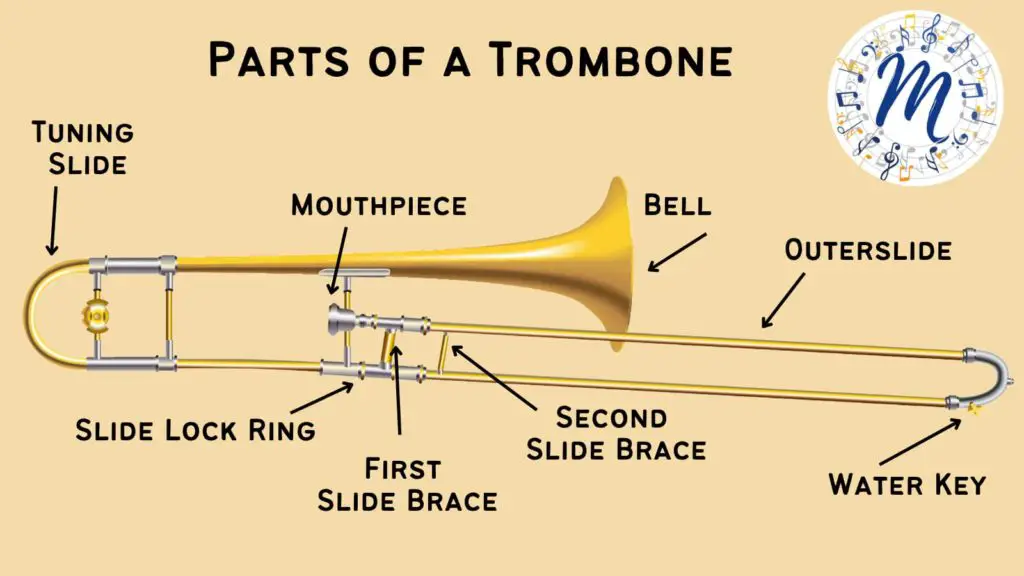“Seventy- six trombones led the big parade, with a hundred and ten cornets close at hand…” Meredith Willson, The Music Man
You may have never seen or heard the musical The Music Man but, you have seen and heard the sounds of a trombone. Trombones are played in a concert or symphonic band, they also are an iconic part of a school marching band. What exactly is a Marching Trombone?
A Marching Trombone is a brass instrument that produces its sound by the player’s lips vibrating (buzzing). Instead of valves, like all other brass horns, the trombone has a slide. The slide is moved in towards the musician or away to produce different notes. There are 7 slide positions and the most common type of trombone is a tenor trombone.

Are there Trombones in a Marching Band?
Yes! Most high school and college bands have trombone sections in their marching band.
Yet, there are some schools that may ask you to switch to marching baritone for one of two reasons.
One reason is that the band and previous band directors at the school have not had the trombone as part of their marching band. The second reason is all about marching drill.
The patterns marching bands make on the field is known as “drill”. Reading a drill chart shows the marcher where they march next.
You may have to switch to the marching baritone because the drill is tight and to do a move that is known as a pass-through. A pass-through is when a marcher must march through a line of other instruments.

The trombone slide makes pass-throughs difficult without hitting someone or damaging your trombone. College marching bands with trombones use the dip and swing method for pass-throughs.
The dip and swing method is performed by dipping your head and horn down to the ground. Once you have passed through, you swing your head and horn back into a normal playing position.
The video below from the 1980 Blue Devils Drum and Bugle corps shows what pass-throughs look like.
Switching to play the marching baritone is done to let trombone players who want to march do so. The slide positions correspond with valves on a baritone. It is up to the musician to remember what valves are substitutes for slide positions. In the chart below you can see the valves and how it relates to slide positions.
| Baritone Valves | Trombone Slide Positions |
| Open (no valves pressed down) | First Position |
| 2nd Valve | Second Position |
| 1st Valve | Third Position |
| Valves 1 and 2 | Fourth Position |
| Valves 2 and 3 | Fifth Position |
| Valves 1 and 3 | Sixth Position |
| Valves 1, 2, and 3 | Seventh Position |
Some trombone players will switch to baritone if asked and other players do not want to switch. It depends on the musician and what the band director decides to do.

Tenor Trombone. These are the marching trombone players use. A marching baritone horn
What is a Marching Trombone Called?
The Marching Trombone does not have a special name. This is because a Marching Trombone is a trombone. It is a trombone being played outside while you march instead of seated in a concert setting.
Some marching bands allow students to play with a plastic trombone, which is known as a “pBone”. A pBone can match the same sound that a brass trombone can produce. They are virtually indestructible, which is good for a marching band setting
These trombones are more affordable than brass ones if you are considering buying an instrument with a limited budget or want a practice instrument for home.
If you want to use a pBone on the field, it is best to ask your band director if it is okay. The pBone is a divisive topic and many directors don’t want their students to march with one.
A plastic trombone, also known as a pBone
There is an instrument that has been sold as a “marching trombone” in the past. The real name of that instrument is the flugabone.
What is a Flugabone?
Yes, there is an instrument called a Flugabone. It is not a made-up instrument that upper-class students joke about on your first few days of band camp.
Flugabone was very popular in the 1970s and the early 1980s. They are not seen in high school and college marching bands today. You might see one if you go to New Orleans and see a brass band with Flugabone marching down the street.
The Fugabone is what it sounds like, a trombone combined with a Flugelhorn. If you have ever seen a Flugelhorn, the Flugabone kind of looks like a giant Flugelhorn, A Flugabone is a valved brass instrument. The body of the horn looks like a trombone slide that has been coiled around the valves.
Flugabones are often mislabeled as bass trumpets or large cornets. The reason why people get confused is because nobody marches the Flugabone anymore. If you aren’t a trombone collector, you are not likely to see someone owning or playing a Flugabone.
Note: Want to know what the difference is between Trumpet, Cornet, and Flugelhorn? This article has all the info! Trumpet VS. Cornet VS. Flugelhorn (A Complete Comparison)
A Flugabone was designed to sound like a trombone. The intonation of a Flugabone can sometimes be fuzzy. People have said that finding the exact pitch on a flugabone is a bit harder than on a slide trombone.
Wessex Bb Flugabone King Flugabone
How Much Does a Marching Trombone Weigh?
A Marching Trombone can weigh, on average, six and a half pounds or more. Most student trombones are around 6 pounds. The weight depends on the brand, metal used, and if there is an F attachment or not.
Pro Tip: If you own an F attachment or want to use one, it will only make your horn heavier. Marching trombonists recommend not using an F attachment on the field because it isn’t needed.
If you are allowed to play with a pBone they are incredibly lightweight. A pBone weighs half of the weight of a standard/student tenor trombone, three pounds.
They do come in a standard metallic brass or silver-like color. They aren’t shiny like a regular trombone and can stand out if there is only one in a line of brass trombones.
The Flugabone typically is around four pounds. The weight of a Flugabone can vary and older models will likely be heavier than newer models.
There are many Flugabones for sale on eBay. Many of the listings do not include accurate measurements or weight and might not be Flugabone at all. Keep that in mind if purchasing through an online auction.
What’s the Difference Between a Marching Trombone and a Flugabone?
While both the Marching Trombone and the Flugabone are different instruments. They have some similarities like the forward-facing bells around 8 inches in diameter. They both are able to be used with a normal trombone mouthpiece and are in the key of Bb.
Here is a chart comparing three different Marching Trombones and three different Flugabones. You will see the similarities between both instruments.
| Name of Brand and Model Number | Instrument Type | Key | Bore Size * | Shank Size ☐ | Bell Diameter | Cost |
| Etude ETB – 100 Series Student | Trombone | Bb | 0.495 inches | Small | 8 inches | $280 |
| Yamaha YSL-354 Student Series | Trombone | Bb | 0.500 inches | Small | 8 inches | $2,077 |
| Kanstul 750 | Trombone | Bb | 0.500 inches | Small | 8 inches | $1,650 |
| Lake City FLB 415 | Flugabone | Bb | 0.492 inches | Small | 8.7 inches | $850 |
| Wessex FB124 | Flugabone | Bb | 0.500 inches | Small | 8.46 inches | $1,135 |
| Kanstul Model 955 | Flugabone | Bb | 0.500 inches | Small | 8.5 inches | $3,100 |
* Bore Size – The diameter of the tubing used in the instrument’s design. For trombones, it refers to the size of the tubing that makes up the inner hand slide.
☐ Shank Size – The shank refers to the size a mouthpiece should be to fit comfortably
(not too tight and not too loose) into the lead pipe of the instrument.
There are some differences between a Marching Trombone and a Flugabone.
Two differences between the horns are their sizes, shape, and if they have slides/or valves instead. A Marching Trombone is a normal tenor trombone in size, and length. They have a slide that is moved to produce different notes and is a common marching instrument.
The Flugabone is a small and compact instrument. There are no slides, but three valves that are raised or lowered to produce different notes. Not having a slide attached to it makes the flugabone look a bit like a marching baritone.

The Marching Trombone and the Flugabone are not the same in weight which we touched on in the last section. The Flugabone is a few pounds lighter than the Marching Trombone.
The Marching Trombone is just a regular tenor trombone that you are now marching with.
Top Tip: The trombone you use for your Marching Trombone might be a student/or old horn you don’t use anymore. Try to not bring an expensive instrument out to march with on the field if you can.
The Flugabone was made FOR marching. It’s lightweight, portable, allows for tight drill, and the horn angles can be more uniform. They also prevent trombone players from having to switch to a baritone for the season.
One final difference is, that people don’t march with Flugabones any longer. Seeing one flugabone is pretty rare. Seeing an entire section or more than one Flugabone player in a marching band is like seeing it snow in Florida. It has happened a few times in the 1970s and 1980s, but you shouldn’t expect to see it again anytime soon.
The Pros and Cons of Playing the Trombone vs A Flugabone in Marching Band?
All instruments come with their own set of pros and cons, including marching instruments. Both the Marching Trombone and Flugabone have pros and cons associated with them.
Marching Trombone Pros
- Trombones add a richer and higher pitch to music which helps the brass section have a more balanced sound.
- The ability to include smears in the band’s music. A trombone smear is a very fast slide up or down between two notes. A smear is also known as a glissando.
Trombones are great for smears because they can move between slide positions easily. Unlike all other instruments that have to rapidly finger every note to play a glissando.
A great example of trombone smears is the Sabre Dance from Gayane Suite by Aram Khachaturian.
- Ease of transitioning from concert to a marching setting. Trombones are loud enough that extra effort to be heard isn’t needed.
It always surprises new members of any marching band, how different it is to play while marching.
The way you hold your instrument can change as well as how much of an effort it takes to control your wind flow. A Marching Trombone player won’t need to change anything.
In marching band, the instruments are loud, louder than in a concert setting. When marching you need to project your sound which takes a lot of air. For trombone players this is easy. - Marching Trombones are something audiences expect to see when they see a marching band. There are also “tricks” Marching Trombone players can do that fans love. One of these tricks is known as “Trombone Suicides”.
To do this trick, all the trombone players must line up side-to-side. In an alternating order, the musicians will follow the pattern of “up-right up down up left up-down”.
Every other person in the line will come up to a playing position and then swing their bodies and horns to the right. While the player next to them is bent over, and then returns to facing the front again. This pattern is alternated and performed at various speeds.
If you are not bent over enough you will get hit in the head by the person next to you (hence the ‘suicide’ part of the name).
Note: Some high school marching bands allow their students to do Trombone Suicides. Others don’t allow them due to the risk of injury to the musician and damage to the instruments as well.
Here is a video of Colorado State University’s marching band doing Trombone Suicides. While blindfolded! If you listen closely you can hear the musicians saying “down right, down left” as they do this trick.
Marching Trombone Cons
There are a few cons that come with playing the Marching Trombone.
- It’s a constant challenge to keep all horn angles at the same height. In marching band having bells raised, and pointed in the same direction at the same height is a big thing. For Marching Trombones, if your horn angle droops it is very noticeable to audiences.
In marching practices, it is normal to hear the drum major/band director mention horn angles.
Marching bands came from military drum and bugle corps which had high angles. Everyone holds their instruments the same way. Which makes the band look like a unit, looks clean, and ensures the best sound quality. - The intonation can be a mess. While sitting in a concert setting you can adjust your tone to match the other members of your section. You also can place a tuner on your stand to track your intonation. In a marching band, the intonation of the Marching Trombone section becomes difficult.
Having a Marching Trombone section that is in tune is possible. It takes a lot of concentration which is hard to do at times while you march. Marching requires you to think about many things at once like:
🎵 Playing the correct notes.
🎵 Looking up at the drum major to stay on the tempo and back down to your music.
🎵 Being mindful of your horn angles and body angles that marching band requires its players to use.
🎵 Remember where your spot is in the drill, and what your next move is.
🎵 How many counts do you have to get there?
🎵 Make sure you are keeping in line with the other band members. This is referred to as “Dressing” or “Dressing Down”. It requires a musician to use their peripheral vision to see if they are in line.
- Trombones are not small instruments and with slides in the 7th position, the trombone only becomes longer.
Playing the Marching Trombone in the marching band also means a tight drill is hard to create due to the need for space for Marching Trombone slides.
Flugabone Pros
There is a reason why Flugabones were advertised as “marching instruments” and those reasons are the pros of marching with a Flugabone
- Using a Flugabone in a marching band instead of a Marching Trombone won’t change the sound of the music or removes the voice that a trombone adds to a band. The horn angles will be uniform as well.
- Fluglebones are lightweight.
Baritone players have to hold a heavy instrument and it can make your arms and wrists sore. A Marching Baritone can weigh anywhere between 10 to 20 pounds.
A Marching Trombone can weigh 6 or more pounds, but a Flugabone weighs less than both of these brass instruments. - They are easy to travel with. Since Flugabones are compact instruments, their cases are smaller as well, which means they take up less space in an instrument truck.
The shape of a Marching Trombone requires a long case which can make loading a truck difficult, the Flugabone doesn’t require a long case and can easily be loaded into a truck. - The lack of a slide on a Flugabone. Because there is no slide, the Flugabone works well in tight drill and can easily execute pass-throughs, and removes the horn angle issues that Marching Trombones face.
Flugabone Cons
While the Flugabone sounds like a great substitute for the Marching Trombone, one of its major cons is that nobody uses them anymore. The instrument itself was popular in the 1970s and early 1980s but fell out of fashion. When the Flugabone was not as popular, many instrument companies stopped making them.
Two brands that made a lot of Fugabones were King Musical Instruments (now owned by Conn-Selmer, Inc) and F.E. Olds. The three brands in the comparison chart are the only companies making Flugabones presently. You can find old Kings and Olds horns on eBay but they aren’t always in good shape or the correct instrument.
Many of the people who own Flugabones are musicians who collect “vintage” instruments. They are becoming less common and the musicians tend to have older models of horns rather than new ones. You may see a Flugabone in a New Orleans-style jazz band because of its pros.
No high school marching bands or college marching bands (in the US) have Flugabone players. They have a trombone section, or the trombone players have to switch to the Marching Baritone.
Another con that comes with playing the Flugabone is intonation. The middle-range notes can be difficult.
- Finding the exact note and pitch on a Flugabone is much harder than on a Marching Trombone. Any band, concert, or marching, needs to be in tune and precise when it comes to the music. Flugabones can not guarantee the same accuracy that a Marching Trombone or Marching Baritone can.
- Many Marching Trombone players dislike switching to Marching Baritone because of the valves. The Flugabone requires its players to memorize valve positions. Remembering the valves as if they were side positions is challenging.
Most Marching Trombone players would pick switching to a Marching Baritone than a Flugabone. When it comes to having to play an instrument with valves the baritone is what most schools have. It is easier to rent or borrow a Marching Trombone or Marching Baritone from your school or instrument shop than it would be trying to find a Flugabone.
How to Hold a Trombone
It is important that any musician knows how to hold their instrument. Holding a Marching Trombone is relatively easy which is great news for new players!
The first step to holding your Marching Trombone is to know where the slide braces are. There are two: the first slide brace and the second slide brace.
Note: Check out our in-depth article that will get you holding your instrument like the pros! How to Hold a Trombone (Hand Position Guide)
The picture below shows where these slide braces are located.

Once you have located the slide braces it is time to position your hands. The trombone is held and supported by your left hand and arm so we will start with the left hand.
Hold your left hand out with your middle finger, ring finger and pinky wrapped into your hand.
The pointer finger and thumb will make a “finger gun” shape. That is the general shape you will have your hand in.
The left thumb will wrap around the base of the instrument.
The three fingers that you have wrapped into your palm will wrap around the first slide brace.
Your pointer finger will reach up to rest against the mouthpiece. If you aren’t able to reach the mouthpiece with your pointer finger, you can use your middle finger.
Now that the left hand is positioned properly, it is time to move to the right hand. With your right hand, you will hold the second slide brace with your thumb on one side of the brace.
The pointer and middle fingers will gently hold the other side of the brace in a pinching shape. Keep the fingers of your left hand together when you move the slide, or else it can pinch your pinky when you play.
Here is a picture of what the hands should look like while holding a Marching Trombone.
Here is a video demonstrating the way to hold the Marching Trombone.
How to Hold a Flugabone
Holding a Flugabone is similar to how a Marching Baritone is held. With your right hand, make a pistol shape but don’t curl in your middle finger, add it to the “barrel” of the pistol.
Pick up the horn and place your right thumb around the valve casing. Take your pointer and middle finger and put it in front of the valve casing. The ring and pinky fingers will grip the bottom of the valve casing or hold onto the pipe that connects to the valves.*
Below is an image of musician John Powell playing the Flugabone.
Note: There are no guides or videos that explain how to hold the Flugabone on the internet. The grip and positioning of the right hand seem to be different from musician to musician. The description above is from general observation and study of the construction of the flugabone.
How to hold a Marching Baritone
This video explains and shows how to hold a marching baritone. While the grip is not the same, the arms/body/wrists should be the same as it would be for a baritone.
What is the Best Marching Trombone?
The best Marching Trombone is a “student trombone”. This is because they are more durable than intermediate or professional model trombones. If you want to own your own Marching Trombone, the best horn you can get is the Yamaha YSL-354 tenor trombone.
Marching Trombones, like all marching brass instruments, will end up getting scratched or dented. Using a student trombone is a good idea because they are made by machines. They use metals that are able to withstand some wear and tear.
Student trombones have smaller bores which makes playing a note easier. It doesn’t need as much blowing and can still play when you are out of breath. Marching and playing in the stands can make your mouth tired.
Some college marching bands have Marching Trombones that are provided by the school. These are high-quality horns only to be used during games. At practice, they play with a horn that is not made with high-quality materials because of the risk of damage. Some high schools may operate the same way, if not a student trombone is the way to go.
Top Tip: A general rule of marching band is “Don’t use your best/most expensive instrument for marching”. If you have an intermediate or professional level horn you should not use it to march. The sound is better with a nicer and higher quality horn, but they are expensive. Both high school and college students should only use their good horns in a concert setting.
There is a lot of debate when it comes to naming the best Marching Trombone. There is no “wrong” trombone for marching band. Whatever you choose is going to sound the same as the other trombones on the field.
Yamaha is a well-known and trusted company. They only produce good-quality horns that can be used for years. The YSL-354 tenor trombone is like professional horns but easier to play and very durable. If you can’t get the YSL-354, a great alternative would be the Etude ETB-100 Series Student Trombone.
What is the Best Flugabone?
The best Flugabone is much harder to determine because they are not seen in school marching bands. Back when Flugabone was popular there was one horn that musicians tended to favor. It was the King 1130 Flugabone.
Unfortunately, King no longer makes Flugabones. You can find one on eBay or any other auction website if you want to own your own King Flugabone. Every musician has a different opinion on which Flugabone is the best. For newer models of Flugabones, the Kanstul 955 Flugabone is the best for beginners.
Where Can I Buy a Marching Trombone?
There are a bunch of different places to buy a Marching Trombone! You can buy a Marching Trombone secondhand on eBay, Reverb, or local Free and For Sale Facebook pages. A secondhand trombone is as good as a brand new one.
You can go to your local instrument/music supply store and find a horn to buy. You can also look online for a Marching Trombone at music company websites. Here are some great online music stores that sell Marching Trombones:
- Woodwind & Brasswind
- Music & Arts
- Sweetwater
- Conn – Selmer
How Much Does a Marching Trombone Cost?
There are a lot of different variables when it comes to the cost of a Marching Trombone. If you buy from a local music store or an online supply company the prices vary. Not all stores sell their instruments at the same prices. Used Marching Trombones are always going to be less expensive than new horns.
The range in prices of a good-quality student tenor trombone is anywhere from $269.99 all the way to $2,000 +. Many music stores offer payment installment plans. That means you can buy a Marching Trombone and pay a fixed amount per month until the instrument is paid off.
Top Tip: Some schools offer rental programs as well as “rent-to-buy” programs. Rent-to-buy programs involve paying a rental fee and at the end of the year, the student will then own the instrument. These instruments may be well worn but they play and that is the important part.
You should not be pressured into buying a Marching Trombone. There are so many rental options that give your musician a good quality horn at a manageable price. Most instrument rentals charge a flat rate per month. The rate also includes a cleaning/repair fee when the instrument is returned.
If you chose a rental program, find out if they offer instrument insurance. A rented instrument with insurance means your Marching Trombone will be repaired at the shop. If there is significant damage, the cost of the repair will not be solely on the owner. Instruments are expensive but no band director will ever turn down a student who wants to join the band.
The quality of the instrument doesn’t make you a musician. What makes you a musician is what you can do with that instrument.
Summary
A Marching Trombone is a classic marching band instrument. Most high schools and college marching bands have Marching Trombones.
There are some schools that may need a trombonist to switch to the marching baritone for a season. Bands may do this to march drill that is tighter and utilizes pass-throughs. The slide positions used for trombones can be translated to valve positions.
Marching Trombone is another name for a regular concert tenor trombone. Some schools let students use a “pBone” which is a colorful plastic trombone. There is an old instrument that was sold as a Marching Trombone but looks nothing like a trombone.
That instrument is the Flugabone! Flugabones use valves instead of a slide to play
different notes. A Flugabone can be confused with a bass trumpet or a large cornet.
It is likely you have never seen a flugabone. That is because the instrument was popular in the 1970s and early 1980s. Flugabones are not popular anymore. Some instrument production companies no longer sell or make flugabones.
The weight of a Marching Trombone depends on the material used and the brand that made the horn. Most Marching Trombones will weigh around 6 pounds. The Flugabone is much lighter than a Marching Trombone, they only weigh around 4 pounds.
There isn’t one trombone brand that is better than the other, but the model that is the best is a student model. The student trombones are more durable, sound high-quality, and made with standard materials. Their small bores make playing easier so you can still play when you are out of breath.
One important rule for marching band is “Don’t bring your best instrument for marching”. Instruments can get damaged, dented, or scratched. Repairing and using your best instrument can be expensive. Save your good horn for concert settings if you can.
If you are interested in buying a Marching Trombone you can visit a music shop, a music supply company website, or buy one from eBay. You can rent a trombone and should not feel pressured to buy an instrument if you can’t afford one at the moment.
Up Next:
Trombone Sound Troubleshooting Guide (Fuzzy, Airy, Muffled, Weird)
We hope this article has been helpful and informative for you in your musical journey. Please let us know if there is anything that we could add or change to make this article a better resource for our readers.
Please e-mail us at: [email protected] to let us know how we are doing!
Disclaimer: This post may contain affiliate links. We only recommend high-quality products that are used and recommended by real musicians. If you use these links to buy something we earn a small commission.

